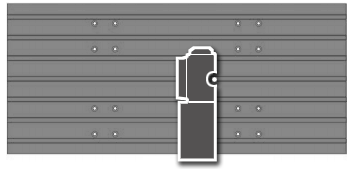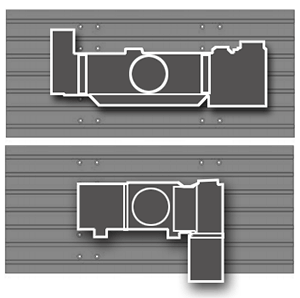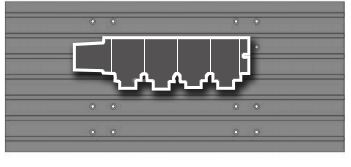Downhill From the Start
In the gently rolling hills a few kilometres outside of Hanover, Germany, lies a sleepy 18th Century farm, which appears very much like many others dotting the landscape. The numerous outbuildings are half-timbered with bowed walls and shingled roofs, yet these contain not livestock and hay, but rather a state-of-the-art industrial design and production facility. Despite a distinct lack of mountains nearby, this farm in Lower Saxony is home to Nicolai GmbH, producer of some of the world’s finest mountain bikes.
Nicolai Mountain Bikes is owned and operated by engineer Karlheinz Nicolai. Offering custom bikes and frames for serious amateurs and professional competitors worldwide, the company’s goal is simple: “We want to build the best mountain bikes in the world,” says Nicolai. According to the industry press, they are well on their way to doing just that.
Karlheinz Nicolai began his career after graduating with a degree in mechanical engineering from Hanover University in 1994. Shortly after, he accepted an internship with bike development and engineering company AMP Research in Irvine, California.
“I wanted to broaden my view of the world – and of business,” he says. “I learned a great deal at AMP, in particular, the American way of getting things done with as little fuss as possible. That stood me in very good stead. The experience at AMP also sparked my interest in serious mountain biking.”
On his return to Germany, Karlheinz founded Nicolai GmbH after bidding on and winning an R&D contract from another American company, Mongoose Bicycles. The new company’s remit was to develop and build a new frame for a racing bicycle.
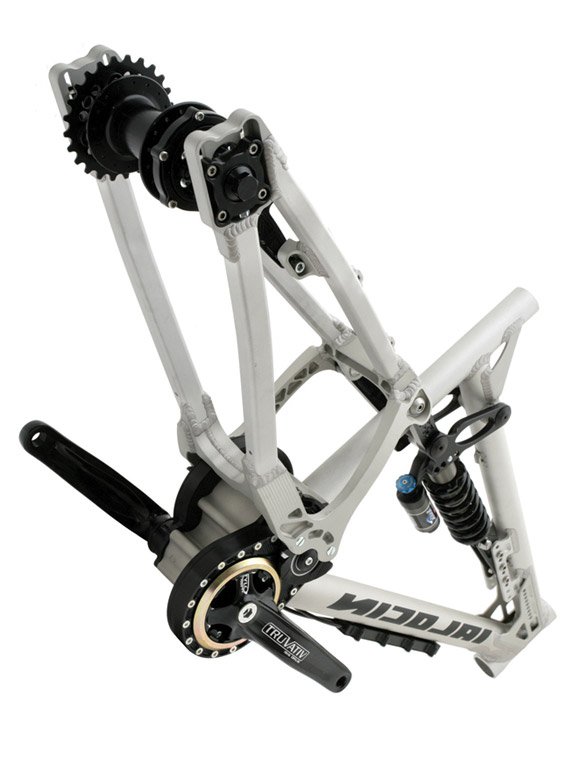
“At that time, I was just a one-man show, working from my garage at home.” he remembers.
The frame that Nicolai developed was raced in the National Off-Road Bicycle Association championships that year and, to the surprise of the designer, won.
“Suddenly, overnight, I became famous as the person who designed the winning frame,” continues Nicolai, jokingly. The punch line was that Mongoose immediately placed an order with Nicolai for 1,000 frames.
“This was a serious shock,” he recalls. “I had no production or manufacturing capability at all, so I decided to outsource everything and just assemble the finished product.”
This turned out to be far from the perfect arrangement. Quality control was extremely difficult to manage, and dealing with vendors was time consuming and often frustrating. Although the fledgling Nicolai GmbH ultimately fulfilled the order, it was touch-and-go.
“It was the most stressful period of my life.” Nicolai remembers. “That’s when I decided in the future to handle all manufacturing in-house.”
In-House Production, In-House Versatility
In 1997, Karlheinz Nicolai moved his family and his business to the sprawling farm in the country that both continue to call home.
“I’d always admired this house,” he says. “So when the owner passed away and the family decided to put it on the market, we moved in.”
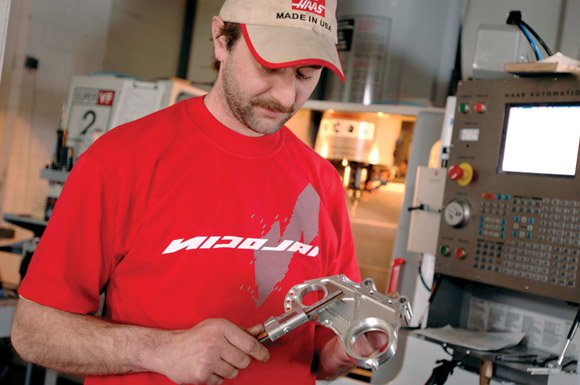
Finally, the young firm had space in which to operate and grow. And grow it did. Having begun with older, used machines, Nicolai knew that long-term success lay with investing in modern, state-of-the-art machinery and software. In 1999, the company purchased a new CNC machine, which gave rise to “an explosion of productivity.” Nicolai was on its way.
In 2005, when Karlheinz Nicolai went looking for a vertical machining centre, he turned to a friend for advice.
“He’d been successfully running a Haas VF vertical machining centre for the last 10 years without any trouble, so I decided to check out the Haas machines,” notes Karlheinz.
“We had a strict budget with which to purchase not just the machine, but all the new SK40 tooling we would need to get started. It quickly became apparent that the Haas VF-2SS was the ideal machine for our applications. There’s nothing on the market that compares with it for price and performance: a relatively compact machine that can machine small and larger parts at high-speed. We needed a 12,000-rpm spindle, because we machine a lot of aluminium. We got all this and more with the VF-2SS, and remained within our budget. Even though we financed the machine over several years, it really paid for itself in the first few months.”
One of the main advantages of in-house machining is the speed with which new ideas can go from the drawing board – make that computer screen – to a finished prototype. Karlheinz says, “We design primarily in SolidWorks, and use both ESPRIT and VisualMill on the CAM side.” Design, programming and production are under one roof, and seamlessly integrate in an environment where designers, programmers and machine operators work closely together. The VF-2SS fit in perfectly.
Nicolai GmbH selects employees carefully, preferring to train motivated individuals with conventional machine shop experience onsite. And with only 15 full-time employees and a backlog of orders, it’s important that each person and every machine is productive from the start. The logical, user-friendly Haas control makes CNC machining easier to understand, reducing operator error and training time. Nicolai feels this has been a great advantage to his firm.
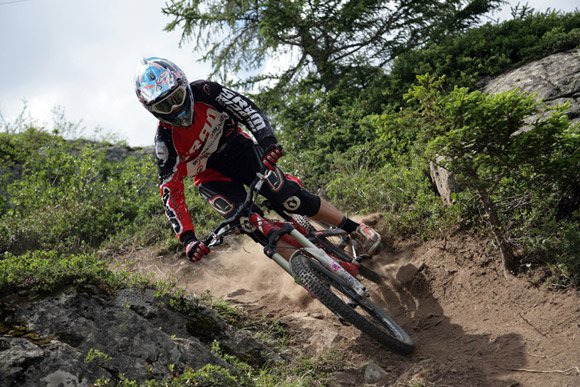
The Nicolai G-Boxx Project
The catalyst behind the purchase of the Haas VF-2SS was one of Nicolai’s most challenging and revolutionary products: the G-Boxx bicycle transmission.
Most conventional bicycles use a derailleur to change gears (see sidebar page 33). But these are far from ideal in the fast-paced and demanding world of serious mountain bike racing. So in 1999, Karlheinz Nicolai decided to design something completely different: a bicycle transmission using a planetary-gear cartridge and robust AlCuMg1 aluminium casing incorporated into the frame design.
The complicated casing for the G-Boxx transmission was the Haas’ first critical test, and the results were a resounding success. The development phase of the project required making and testing a large number of design prototypes, and the Haas was just the machine to get the job done. Now that the product is on the market, Nicolai can turn a solid aluminium billet into a finished G-Boxx casing in just 18 minutes.
The VF-2SS continues in daily use, not only for the G-Boxx, but also for a multitude of short runs, prototypes and tooling of all sorts.
“We machine a lot of parts where we need less than 100 pieces,” Nicolai says, “or where it’s just not economically feasible to make a casting or have the pieces extruded. In such cases we machine them from solid stock on the Haas.”
Having this production capacity in-house allows Nicolai to keep costs under control, with the flexibility to rapidly adjust production on the spot. This is exactly the kind of rapid-reaction management needed by a small manufacturer to stay competitive in today’s global marketplace. Decisions made today are implemented on the production floor today.
Almost a decade after moving his business into the picturesque farm, Karlheinz Nicolai surveys the ordered workrooms filled with designers, welders, machinists and their equipment. Looking over the rows of bike frames awaiting completion and delivery to eager customers, he says quietly, “When we started here, I never imagined we’d end up needing every single one of the 5,000 square meters of floor space.”
It’s safe to say that none of that space is more productive than that occupied by the Haas VF-2SS.
“It’s a relatively small machine, but it has made a very big difference to our company and our future.”
A Perfect Bike is a Perfect Fit
A bicycle should fit the rider’s anatomy and riding style as closely as possible, and ordering a Nicolai bike is a bit like having a suit made to measure by a tailor. The customer places a detailed order, and the bike or frame is built to those exact specs.
Many professionals order the frame alone, and add wheels and other components themselves from a variety of sources. Nicolai frames may be ordered in S, M, L, XL, XXL, or any custom size the buyer specifies. The list of additional options is extensive. For 2007, buyers may choose from 23 different frame designs as the starting point for their winning ride. Frame prices start at 849 Euro.
For riders who prefer to purchase a complete bike, Nicolai offers 13 models assembled in-house using Nicolai frames, and incorporating other components of professional quality carefully matched to that frame. Here, again, the buyer has countless options from which to pick and choose. Prices for complete bikes start at 2499 Euro.
The Derailleur and the G-Boxx
The derailleur is a device used on chain-driven bicycles to allow gear changes – rather like the transmission effects gear changes on an automobile. The concept dates back to 1905, when touring cyclists used primitive derailleurs where the jockey wheel was brazed to the chainstay. Often disallowed in road racing in those days, derailleurs required freewheeling which gave their users a considerable advantage over fixed wheel riders who had to contend with peddle scrape in turns.
This changed in 1938, when Simplex introduced a revolutionary derailleur having a jockey wheel capable of moving in and out to effect gear changes, while also moving forward and backward according to the size of the sprocket. Simplex’s design incorporated a cage similar to those still in use on some derailleurs to take up slack in the chain. However, the Simplex system had a serious weakness: it was very sensitive to dirt and debris, and required frequent cleaning and lubrication. Despite this, it was so successful that it was immediately allowed in the Tour de France, and dominated racing through World War II.
After the War, Tullio Campagnolo invented the parallelogram front and rear derailleurs, which revolutionized cycling in the post- War decades. Campagnolo’s parallelogram system was fast and more reliable than the Simplex design, and the cable-operated front derailleur was a dream compared to previous systems. “Campy equipped” became the motto for professionals and serious amateurs the world over. Later modified by Suntour, the basic Campy design remains in wide use today.
However, the last couple of decades have brought tremendous change to the biking world, including the emergence of competitive mountain biking. This relatively new sport – accompanied by significant advances in bicycle frame design, construction materials and suspension technology – has brought many new challenges to bike riders, designers and manufacturers. For example, when you’re hurtling down a rocky mountain pass at anything up 80 kph, the last thing you really want is a vital and fragile derailleur dangling from the rear of the frame, vulnerable to damage from rocks or a spill. So in 1999, Karlheinz Nicolai set out to find an alternative solution to the exposed derailleur.
In the past, enclosed transmissions were always too heavy for leisure bikes, let alone competition machines. Now, incorporating lightweight machined alloys, Nicolai has come up with a revolutionary design that is much more robust than the traditional derailleur, without any added weight.
The G-Boxx – as Nicolai calls his invention – is not a derailleur at all, but rather an enclosed transmission using a planetary-gear cartridge. This system eliminates the rear derailleur entirely, and replaces it with the now centrally located transmission integrated into the frame itself. Overall weight distribution and balance are markedly improved, but perhaps the most significant advantage is the ability to now change gears while standing still, or even when the rear wheel is locked. The G-Boxx raises the bar in mountain biking to a new level.
The first Nicolai production bike frame to be outfitted with the G-Boxx transmission as standard is the flagship of the company’s fleet: the Nucleon TST. An extreme downhill and free ride machine developed in association with the KRC-Nicolai race team, the Nucleon TST is a contender in the world downhill championship series.
As well as fitting the G-Boxx to its own products, Nicolai has also formed a subsidiary called Universal Transmissions to market the patented G-Boxx system to other bicycle manufacturers worldwide.
With the Haas machine we can have a prototype finished in the time it would take just to communicate with vendors and get a price quote on making the part outside.
Karlheinz Nicolai


